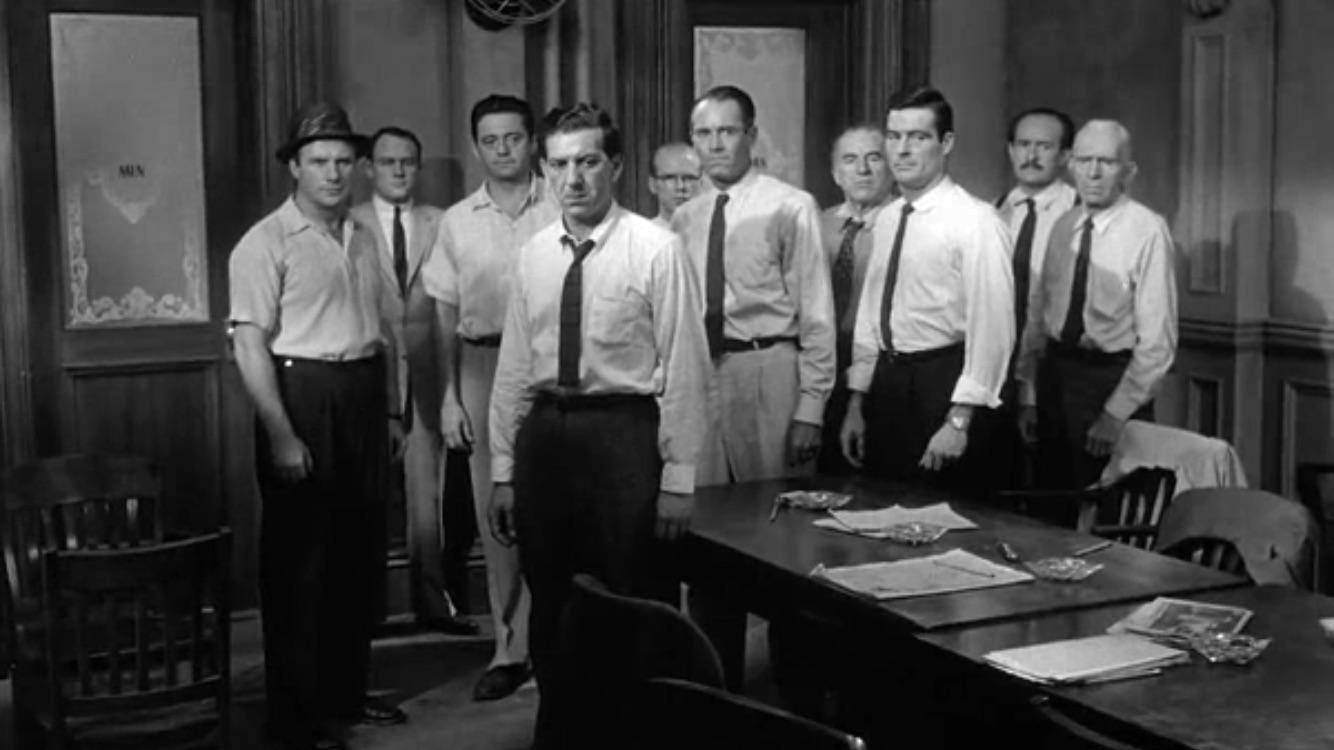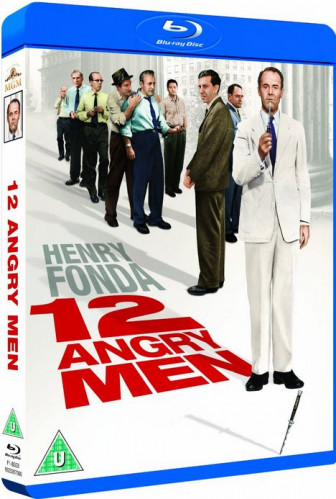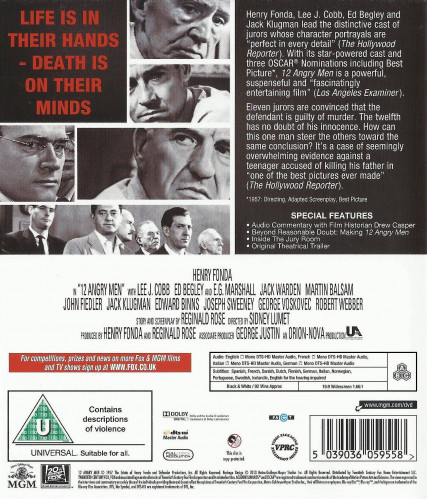12 ANGRY MEN [1957 / 2013] [Blu-ray] [UK Release] Life is in Their Hands – Death is on Their Minds! It Explodes Like 12 Sticks of Dynamite!
Henry Fonda, Lee J. Cobb, Ed Begley and Jack Klugman lead the distinctive cast of jurors whose character portrayals are "perfect in every detail" (The Hollywood Reporter). With its star-powered cast and three Oscar® nominations including Best Picture, ‘12 ANGRY MEN’ is a powerful, suspenseful and "fascinatingly entertaining film" (Los Angeles Examiner).
Eleven jurors are convinced that the defendant is guilty of murder. The twelfth has no doubt of his innocence. How can this one man steer the others toward the same conclusion? It's a case of seemingly overwhelming evidence against a teenager accused of killing his father in "one of the best pictures ever made" (The Hollywood Reporter).
FILM FACT No.1: Awards and Nominations: 1957 Berlin International Film Festival: Win: Golden Berlin Bear for Sidney Lumet. Win: OCIC Award for Sidney Lumet. 1957 Cahiers du Cinéma: Nominated: Top 10 Film Award for Best Film for Sidney Lumet [Tenth Place]. 1957 Locarno International Film Festival: Win: Special Mention Award for Sidney Lumet. 1957 New York Film Critics Circle Awards: Nominated: Best Film. Nominated: Best Director for Sidney Lumet. 1958 Academy Awards®: Nominated: Best Picture for Henry Fonda and Reginald Rose. Nominated: Best Director for Sidney Lumet. Nominated: Best Writing, Screenplay Based on Material from Another Medium for Reginald Rose. 1958 Golden Globes: Nominated: Best Motion Picture in a Drama. Nominated: Best Actor in a Drama for Henry Fonda. Nominated: Best Supporting Actor for Lee J. Cobb. Nominated: Best Director for Sidney Lumet. 1958 BAFTA Film Awards: Win: Best Foreign Actor for Henry Fonda [USA]. Nominated: Best Film from any Source [USA]. 1958 Directors Guild of America Awards: Nominated: Outstanding Directorial Achievement in Motion Pictures for Sidney Lumet. 1958 Edgar Allan Poe Awards: Win: Best Motion Picture for Reginald Rose. 1958 Grand Prix de l'UCC Awards: Win: Best Motion Picture. 1958 Italian National Syndicate of Film Journalists: Win: Silver Ribbon Award for Best Foreign Film (Miglior Film Straniero) for Sidney Lumet. 1958 Writers Guild of America: Win: WGA Award (Screen) for Best Written American Drama for Reginald Rose. 1960 Blue Ribbon Awards: Win: Best Foreign Language Film for Sidney Lumet. 1960 Bodil Awards: Win: Best American Film (Bedste amerikanske film) for Sidney Lumet (director). 1960 Kinema Junpo Awards: Win: Best Foreign Language Film for Sidney Lumet. 2008 Online Film & Television Association: Win: OFTA Film Hall of Fame for ‘12 ANGRY MEN’ Motion Picture.
FILM FACT No.2: The 1957 film was shot in New York and completed after a short but rigorous rehearsal schedule, in less than three weeks, on a budget of $337,000 (equivalent to $3,006,000 in 2018). Reginald Rose and Henry Fonda took salary deferrals. At the beginning of the film, the cameras are positioned above eye level and mounted with wide-angle lenses, to give the appearance of greater depth between subjects, but as the film progresses the focal length of the lenses is gradually increased. By the end of the film, nearly everyone is shown in close-up, using telephoto lenses from a lower angle, which decreases or "shortens" depth of field. Sidney Lumet stated that his intention in using these techniques with cinematographer Boris Kaufman was to create a nearly palpable claustrophobia.
Cast: Martin Balsam (Juror 1), John Fiedler (Juror 2), Lee J. Cobb (Juror 3), E.G. Marshall (Juror 4), Jack Klugman (Juror 5), Edward Binns (Juror 6), Jack Warden (Juror 7), Henry Fonda (Juror 8), Joseph Sweeney (Juror 9), Ed Begley (Juror 10), George Voskovec (Juror 11), Robert Webber (Juror 12), Rudy Bond (Judge) (uncredited), Tom Gorman (Stenographer) (uncredited), James Kelly (Guard) (uncredited), Billy Nelson (Court Clerk) (uncredited), John Savoca (The Accused) (uncredited) and Walter Stocker (Man Waiting for Elevator) (uncredited)
Director: Sidney Lumet
Producers: George Justin, Henry Fonda and Reginald Rose
Screenplay: Reginald Rose (story/screenplay)
Composer: Kenyon Hopkins
Cinematography: Boris Kaufman, A.S.C. (Director of Photography)
Image Resolution: 1080p (Black-and-White)
Aspect Ratio: 1.66:1
Audio: English: 1.0 DTS-HD Master Mono Audio
French: 1.0 DTS-HD Master Mono Audio
Italian: 1.0 DTS-HD Master Mono Audio
German: 1.0 DTS-HD Master Mono Audio
Spanish [Castilian]: 1.0 DTS-HD Master Mono Audio
Polish: 2.0 Dolby Digital Stereo Audio
English: 2.0 Dolby Digital Stereo Audio
Subtitles: English SDH, Spanish, French, Português (Brazilian), Italian, German, Spanish [Castilian], Mandarin (Traditional), Chinese (Traditional), Danish, Finnish, Icelandic, Korean, Norwegian, Polish, Português, Swedish, French and Italian
Running Time: 96 minutes
Region: All Regions
Number of discs: 1
Studio: 20th Century Fox / United Artists
Andrew’s Blu-ray Review: With the film ‘12 ANGRY MEN’ [1957] this was director Sidney Lumet's dazzling debut, and is based on the Reginald Rose's teleplay, and delivers a masterclass in the pure dynamism of acting, as Henry Fonda's reasonable doubt gradually sways the 11 other jurors from their various prejudices. Just sit back and lap up a dozen terrific character actors like Lee J. Cobb, Ed Begley, E.G. Marshall, Jack Warden, Martin Balsam, John Fleder, Jack Klugman, Edward Binns, Joseph Sweeney, George Voskovec, Robert Webber and of course the brilliant Henry Fonda who carves up the screen into a dozen perfect pieces.
As the story unfolds we learn more about the personalities of jurors and the sometimes heated conflicts among the men are brought to the fore. Juror #8 is the voice of reason and moderation. He openly acknowledges that he doesn't know whether the defendant is guilty or innocent but he's unwilling to make a determination about whether a man should live or die without a thoughtful deliberation. Some of the jurors take their roles seriously including the foreman (Martin Balsam) and the purely logical Juror #4 (E.G. Marshall). Others, however, are compelled by concerns having nothing to do with jurisprudence. Juror #7 is more concerned about being able to make his baseball game then about whether justice is done. Jurors #3 and #10 are blinded by personal demons. They see not a man in the dock but a stereotype or a representative of something ugly from their own lives.
‘12 ANGRY MEN’ creates a mesmerizing drama out of an event that takes place many times every day throughout the United States: A man is tried by a jury of his peers. "Nice bunch of guys, huh?" one juror remarks sarcastically after a particularly heated argument. The juror, played by Henry Fonda, replies, "They're about the same as anyone else." That observation is central to the film, which shows the deliberation of a murder trial where a young Puerto Rican man is accused of killing his father.
The issues that arise illustrate how guilt and innocence are determined. We would like to believe that verdicts result from the merits of the case but the actuality is more complex. O.J. Simpson was in part acquitted because of biases brought into the deliberation room by the jurors. This is one area in which ‘12 ANGRY MEN’ provides compelling and on-target edge of your seat drama. The only instance in which it fails to ring true and this is in large part because of how attitudes have changed since 1957, is the over-the-top bigotry displayed by Juror #10 and his utter prejudice is so overt that, as seen by modern day audiences, its believability is slightly strained.
On paper this courtroom drama had little to get excited about, especially as it features a one room setting, a dozen old-timers spouting off, a first-time director, a non-event. But on film, ‘12 ANGRY MEN’ is transformed into a superlative brew of acting prowess and dynamite direction, and could stand as a screenwriting masterclass in the development of character and plot without resorting to the big stunts, grandiose locations or special effects.
‘12 ANGRY MEN’ is actually a jury room thriller, where Fonda's lone hand declares doubt in the sure-fire guilty verdict of a murder case. As his insidious ability to look at evidence from an alternative, revealing angle gradually begins to swing jurors to his side, it becomes evident that strident opinions have been obscured by a miasma of prejudices and neuroses.
The ‘12 ANGRY MEN’ film is a very memorable and interesting to watch, because it is a great film that really keeps the viewer sucked in. In and of itself, the basic story is incredibly simplistic, with practically the entire film, except for the very beginning and end taking place in one room. However, the film makes great use of that minimalism by continuing to ramp up the tension between those who become convinced of the accused’s innocence and those still holding on to a guilty verdict. Tensions are high and they are that way throughout the film because none of the jurors are able to go anywhere.
The film never reveals whether the men’s verdict is the correct one, for that is not the purpose of the film. The film simply shows the strength of the American criminal justice system. Everyone is entitled to a fair trial and to be judged by a jury of their peers who will give due consideration of the evidence. And if the jury cannot be certain that a defendant is guilty, if there is any reasonable doubt, they must acquit him. The genius of Sidney Lumet’s potent ‘12 ANGRY MEN’ is that we forget all of the action takes place in just one small, claustrophobic space because the dialogue and story move at such a pace!
It’s likely you won’t notice, so wrapped up will you be in the unfurling of an absorbing tale through dialogue that is both complex and unassuming, but the camerawork in this film is truly magnificent. At the beginning, the cameras are all positioned above eye level and mounted with wide-angle lenses to give the appearance of greater distance between the subjects. As the film progresses the cameras slip down to eye level. By the end of the film, nearly all of it is shot below eye level, in close-up and with telephoto lenses to increase the encroaching sense of claustrophobia.
‘12 ANGRY MEN’ is a powerful, historical film that brings to light the American justice system and yet it also examines deeply the intimate ways we relate to each other in our everyday lives. Nearly 50 years after its creation it remains a vital and critical piece of American cinema history. There are those films in life that simply take your breath away...they change who you are, how you think and how you feel. ‘12 ANGRY MEN’ is such a film and one that deserved all of its awards.
12 ANGRY MEN MUSIC TRACK LIST
DANCE OF THE CUCKOOS (uncredited) (Music by Marvin Hatley) [Portion whistled by Jack Warden]
Blu-ray Image Quality – Metro-Goldwyn-Mayer and 20th Century Fox presents the film ’12 ANGRY MEN’ with a stunning Black-and-White 1080p image and enhanced with a wonderful 1.66:1 aspect ratio. With the film you get a lot of close ups of the actors and they really crisp and sharp. Contrast levels are good and stable and the blacks, whites, and greys are also very well balanced. So overall the image presentation is really excellent and there are no large damage marks, cuts, debris, on the image to report in this review, meaning it is a perfect print.
Blu-ray Audio Quality – Metro-Goldwyn-Mayer and 20th Century Fox brings us the film ’12 ANGRY MEN’ with one standard 1.0 DTS-HD Master Mono Audio experience and of course is mainly dialogue driven, which is really excellent, very stable, and you hear all of the actors speak very clearly and precise. So overall there are no serious audio dropouts or distortions to report in this review.
Blu-ray Special Features and Extras:
Audio Commentary with Film Historian Drew Casper: Here we are introduced to Film Historian Drew Casper and we get to hear an in-depth analysis of the film 12 ANGRY MEN’ and hardly seems to take a breath, but does throughout gives the occasional brief gaps to give him some respite. Film Historian Drew Casper eloquently narrates at times, but also gives lots of inputs of vast extraneous details about director Sidney Lumet, plus lots of information about the actor Henry Fonda and much of the rest of the cast and informs us that this film was shot in 20 days just for a mere $250,000 and the way he speaks, obviously is reading some kind of script, but despite this, Drew Casper gives us some other interesting facts, like he tells us to notice that with the continuous audio soundtrack, that no composed music introduces the film, no just natural sounds of the court room and is maintained with the judges monotone monologue to the 12 men of the jury. Drew Casper talks about the first scene in the jury room, where it is one single shot of all the 12 men entering the jury room and then eventually we get the Tile of the film and screen credits appear to set the scene of the ongoing drama in the film. Drew Casper comments that he feels the director Sidney Lumet is up there with the other great directors, such as William Wyler, Orson Wells and Alfred Hitchcock in setting up the start of the film’s atmosphere, in being filmed in one claustrophobic room, and psychologically right for this film. Drew Casper talks about Reginald Rose and how his writing of the original novel brought all 12 characters to life and made it easy for the director Sidney Lumet to also bring those characters to life for this film and especially the tension and clash between each character, especially certain actors explode with anger, especially when one character votes not guilty, and that over time that one person starts some of the other people to start saying not guilty and this really ups the tension half way into the film. Drew Casper goes into great detail about the main 12 actors and their specific varied acting careers and in especially getting to where they are for their part in this film, and also reflects on the attitude of America when the film was released, that period with the era of the “Cold War” syndrome, where America was fighting again the USSR totalitarian regime, meaning no democracy. We find out that Sidney Lumet had a two week rehearsal with all the actors, so that they would perform like there was no camera or director in the room and to act more natural, and also allowed the director to work out where to position the camera for the shoot, and that is why the film was shot in record time of about nine weeks. Drew Casper talks in-depth about the plaudits from different critics; despite the film was a box office disaster in its first week. But very importantly, there was one specific person who viewed the film who was involved with court cases and the jury system and commented that the film was very accurate and realistic in its portrayal of a murder court case, especially in America, and also what actually goes on in the jury room deciding if someone is guilty or not. As we get to the end of the film and we see the 12 jury men leave the court house, and Drew Casper comments, “the film, ’12 ANGRY MEN’ was a significant cultural metaphor for post war America and a shining example of post war Hollywood, that broke with the mould of class and paradigm and that I am proud of doing this audio commentary and thank you for listening.”
Special Feature: Beyond a Reasonable Doubt: Making of ‘12 ANGRY MEN’ [2007] [1080p] [1.78:1] [22:59] One of the main themes in the film that people in the special feature talk about is the concept of reasonable doubt. When somebody doubts a pre-conceived notion, like the guilt of the defendant in this case, is often met with cynicism and hate. But even the doubt of one man can change the attitude of the general population. What is also pointed out is the fact that the most diehard of the jurors will not accept Henry Fonda's character's points as valid, because they have already made up their mind that the person on trial is guilty and they won't back down, but of course over time people start to understand Henry Fonda's logic and start to go his way, especially people pointing out that the elderly man down the hall, as suggested by Juror #9 [Joseph Sweeney], didn’t actually see The Kid, but claimed he had, or perhaps convinced himself he had, out of a desire to feel important. Also very important is the fact that the woman across the street saw only a blur without her glasses because of the marks on the bridge of her nose, yet positively identified The Kid, again, either deliberately lying or confabulating, meaning that confabulation is a memory error defined as the production of fabricated, distorted, or misinterpreted memories about what the woman actually saw. They also praise the screenwriter Reginald Rose for producing a brilliant screenplay, which the actors also praise. We also hear that Henry Fonda saw the TV drama and felt it would be a brilliant film and went round to all the studios and everyone rejected the idea in saying people would not pay to see 12 men in a room talking about a murder case, so Henry Fonda put up his own money to get the film made and also became the Co-Producer. But also wanted Sidney Lumet to direct the film because he had worked on a lot of television projects, but also informs us that filming 12 men in one room was going to be a tall order, but of course Sidney Lumet made a brilliant job and especially wanting to create a real claustrophobic effect to build up the tension, and to achieve this Sidney Lumet wanted to film in three levels throughout the film, starting with above eye level, middle third of the film at eye level and lastly below eye level. One interesting fact we get to hear about, is that after the first week of showing the film in New York, it failed dramatically at the box office and eventually the film disappeared and lost a great deal of money, but was a massive box office hit overseas, and of course eventually became a massive hit in America, and is still today, because the film is still very relevant today, as you would still experience the same drama with jury members and their attitude in a murder trial in saying the person was guilty. So all in all, this was very interesting special feature and definitely one to watch. Contributors include: Michael Asimov [Professor of Law, UCLA / Co-Author of “Reel Justice”], Patricia King Hanson [Executive Producer at AFI], Robert Osborne [Film Historian], Sidney Lumet [Director], Jack Klugman [Juror #5], Jami Floyd [Court TV Anchor for “Best Defense”], George Wendt [Juror #1 with 2006 – 2007 Touring Production], Richard Thomas [Juror #8 with 2006 – 2008 Touring Production], Scott Ellis [Director 2004 – 2005 Broadway and 2006 – 2008 Touring Productions],
Special Feature: Inside the Jury Room [2007] [1080p] [1.78:1] [15:22] We get to hear that the majority of people love TV court room dramas and even more so in films about real court room dramas like the film ’12 ANGRY MEN.’ We are also informed shockingly that in 1943 in America, they would not allow women to attend jury service duty. But it was not until 1973 in America, women were allowed to do jury duty, especially in all 50 States of America. But in the United Kingdom the jury had always been a socially exclusive institution, and historically people had to own land of a particular value in order to qualify. Until 1919, women were automatically disqualified from serving on trial juries, and even after this date local prejudices had the effect of keeping women off the jury. In Leicester, Lincoln and Nottingham, all juries trying serious criminal offences in autumn 1920 had exactly six men and six women; while in Norwich, Bristol and Exeter such juries featured no women at all. The first time men and women served on the jury at the Leicester assizes, on the 26th October, 1920. The Representation of the People Act 1918 famously ended the ban on women voting in general elections. But behind the headline ‘women got the vote’, there was a more complex reality. Some women had already been voting in and been elected into office in various local franchises for half a century. And even when some women secured the parliamentary vote in February 1918, all women in their twenties were still excluded. Moreover, all women were still prohibited from taking part in public life by joining the professions, or by serving as jurors. Today, court evidence is 24 hour media frenzy, as well via the internet, what will be heard in a particular court case for the people who will be doing jury service for that court case, but they say that anyone called to jury service for the first time, should watch the film ’12 ANGRY MEN’ and will get a flavour of what they will experience. At the end of this special feature, we get to view the last scene of Henry Fonda leaving the jury room and utters these prophetic words, “We maybe even letting a guilty man free, I don’t know, but we have a reasonable doubt, that no jury can declare a man guilty, unless it is sure.” So with that, despite this was a short special feature, it is still worth viewing. Contributors include: Jami Floyd [Court TV Anchor for “Best Defense”], Michael Asimow [Professor of Law at UCLA and Co-Author of “Reel Justice”], Gloria Allred [Attorney and Author of “Fight Back and Win”], Robert Shapiro [Attorney and Author], Michael Cobo [Trial Consultant Decisionquest], Tom Morawetz [Professor of Law and Ethics UCONN School of Law], Thomas Nicholson [Jury Foreman at the Robert Blake Trial], Lee J. Cobb [Juror #3] (archive footage) and Henry Fonda [Juror #8] (archive footage).
Theatrical Trailer [1957] [1080i] [1.78:1] [2:14] This is the Original Theatrical Trailer for the film ‘12 ANGRY MEN.’
Finally, ‘12 ANGRY MEN’ despite the film being released in 1957, its examination of the jury system is as valid as ever, and it may be even more important today when media sensationalism has such a strong effect on public perceptions. The movie stresses that the most crucial issue is not whether the jurors think the accused is guilty but, according to the law, whether that has been proven "beyond a reasonable doubt." Henry Fonda, perfectly cast in 12 Angry Men as a man who values reason, leads a troupe of familiar character actors in a movie that makes a virtue out of its cramped setting. Henry Fonda is one of the great movie stars who will be discovered afresh by lots of new generations. What is also totally brilliant about the film ’12 ANGRY MEN’ is that it consists of No action, no special effects, no whizzy camerawork, just powerful dialogue, finely etched characters and a beautifully worked plot and definitely gives you food for thought. Highly Recommended!
Andrew C. Miller – Your Ultimate No.1 Film Aficionado
Le Cinema Paradiso
United Kingdom



